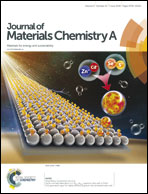Carbon quantum dot sensitized integrated Fe2O3@g-C3N4 core–shell nanoarray photoanode towards highly efficient water oxidation†
Abstract
The construction of integrated heterojunction system photoelectrodes for solar energy conversion is indubitably an efficient alternative due to their effectiveness in charge separation and optimizing the ability for reduction and oxidation reactions. Here, an integrated photoanode constructed with carbon quantum dot (CQD) sensitized Ti:Fe2O3@GCNN (where GCNNs are graphitic carbon nitride nanosheets) core–shell nanoarrays is demonstrated, showing an excellent photocurrent density as high as 3.38 mA cm−2 at 1.23 V versus a reversible hydrogen electrode (VRHE), 2-fold higher than that of pristine Ti:Fe2O3, which is superior over that of recently reported promising photoanodes. In this ternary system (Ti:Fe2O3@GCNN-CQDs), each component plays a specific role in the process towards superior PEC water oxidation: (i) the vectorial hole transfer of Ti:Fe2O3 → g-C3N4 → CQDs; (ii) the introduction of CQDs leads to high catalytic activity for H2O2 decomposition contributing a high rate activity for water oxidation via a two-step-two-electron water-splitting process; (iii) the favorable electron transport behavior of CQDs. This controlled structure design represents one scalable alternative toward the development of photoanodes for high-efficiency water splitting.



 Please wait while we load your content...
Please wait while we load your content...